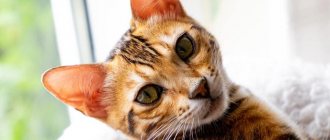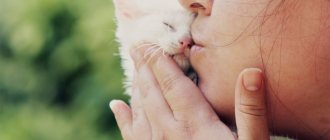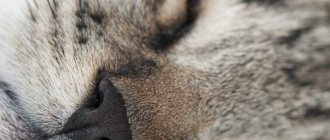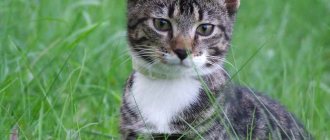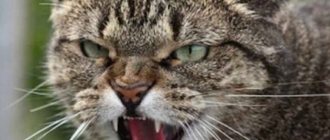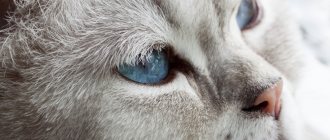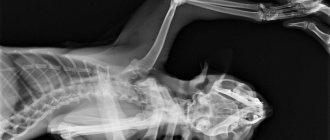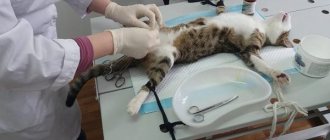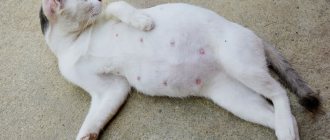Why is my cat's nose dry and warm?
When the nose becomes warm and dry, the skin begins to crack and cause great discomfort to the cat. So, why does a cat have a dry nose and what to do? ?
The cause of a dry nose can be sleep, or, conversely, intense games, a stuffy room, or a violation of thermoregulation processes. If the nose is dry, this means that the cat is hot, and if it is hot and wet, your furry most likely has a fever. Congestion indicates the presence of a viral disease.
Moreover, a number of diseases are asymptomatic for a long time and can be detected only by very small changes in the cat’s well-being. Dry nose with hot ears usually occurs when the temperature rises. Accompanied by apathy, lethargy and lack of appetite, a dry nose may indicate an inflammatory process.
Causes of a hot nose
The body temperature of a healthy cat ranges from 37 to 39 degrees (depending on the breed). During the day it may rise and fall slightly. If you find that your pet has a hot nose, this is not necessarily a cause for concern. After 1-2 hours, touch it again, and if it is no longer hot, but has become cool (or just warm), then there is no need to worry. Usually such temporary changes are caused by the fact that the cat :
- sleeping or recently woken up;
- was active, ran, played;
- leads a sedentary lifestyle and overeats;
- located in a room with low humidity;
- located near heating appliances;
- suffered significant stress.
What are the signs that require contacting a veterinarian?
If the following symptoms are detected in a kitten, you should consult a veterinarian to identify the causes of your pet’s illness:
- malaise, lethargy, apathy;
- dry and hot nose;
- cold and pale nose;
- change in organ color (blue, yellowish, red, white).
The owner should know that a pale and cold organ in a kitten is a sign of:
- chronic illness;
- hypothermia;
- stress;
- low body temperature;
- poisoning;
- complete lack of appetite.
A white and warm nose is a sign of a disruption in the kitten’s circulatory system. The blue and hot organ talks about:
- heart failure;
- inflammation of the respiratory organs;
- oxygen starvation.
When a kitten has a hot and red organ, this is a sign:
- infectious disease;
- rhinitis;
- mechanical damage.
If a kitten has a hot, dry nose and warm ears, then this is not necessarily a sign of illness, because heat exchange has not yet been established in babies, and their body temperature is higher than that of an adult pet. This may be due to the work of the body and its protection from hypothermia.
When should you go to the doctor?
Home treatment for a cat can be quite effective, but with such symptoms you should definitely contact a veterinarian:
- - the cat is morally depressed and oppressed;
- - the animal often snorts, sneezes, shakes its head sharply, constantly rubs its nose with its front paws;
- - purulent nasal discharge;
- - the appearance of dried crusts on the tips of the nose;
- - the cat begins to breathe exclusively through the mouth, its breathing is intermittent and heavy;
- - increase in body temperature;
- — the cat’s forehead hurts very much, and she does not allow herself to be stroked on the head;
- - appearance of fever.
Naturally, the very condition of the animal’s nose does not make it possible to determine for what disease it needs to be treated. A long-term change in the normal state of a cat's nose indicates that all is not well at the moment. Perhaps it will be enough to simply warm the cat or, conversely, slightly cool it and that will be the end of it. But, if you have completed all the necessary maximum actions, and the result is the same, then in this case, be sure to run to the doctor. Cats get sick just like people and need the same medical care.
What should a kitten's nose be like?
A kitten’s nose, just like that of older pets, should be:
- Wet;
- Smooth;
- Cool;
- Uniform color.
Kittens have some special characteristics. Dry nose can appear during sleep, immediately after waking up, during active play, or after severe stress. This state of health should be considered a physiological norm. There may be cases when the dry nose persists all day. This state of health is considered acceptable, provided there are no other signs of disease.
Kittens do not have the skills to maintain hygiene, which can cause a lack of moisture or an excessive amount of it. Small pets who do not know how to lick themselves completely rely on their pets, and sometimes on their owners. Without the proper amount of moisture, kittens' noses can crack, causing discomfort to the baby.
What should a healthy cat's nose look like?
A healthy cat's nose is moist, cool and slightly slippery. The cat regularly licks it, and it is covered with a special secretion that creates a protective mucous membrane. For a cat, the nose is not just an organ of smell. With its help, she determines the direction of the wind, the temperature of an object, and even touches it with her nose along with the vibrissae. Constant moisture on the surface of the nose increases its sensitivity, while a dry nose cracks, causes discomfort and cannot cope with its functions.
A very young kitten has a dry nose because it does not yet know how to lick itself, and the moisturizing secretion is not yet released due to age.
A cat's nose as an indicator of well-being
The main function of a cat's nose is olfactory. Thanks to numerous (almost 20 times more than in humans) receptors, it helps completely blind kittens to freely navigate in space from birth. Babies deprived of sight and hearing always find their mother by reacting to surrounding smells.
The nasal sinuses are separated by a cartilaginous septum, and immediately behind them are the ethmoidal conchae. All odors entering this section are transmitted by receptors directly to the brain, which identifies the sniffed object or subject. The nasal bones of flat-faced breeds are deformed, making it more difficult for them to recognize odors and have a harder time breathing.
In addition to the olfactory, it is important to note the protective and tactile functions. The inhaled air is filtered inside the sinuses to remove dust and microorganisms and warms up to a comfortable temperature. The tactile function is performed by the lobe. This is what cats use to determine the temperature of food.
For the owner of a mustachioed pet, the latest function remains important, allowing you to assess your well-being without undergoing tests. If the animal is healthy, then its lobe:
- a little shiny;
- cool;
- wet;
- has no crusts or scales.
Humidity is achieved thanks to a special secretion secreted by the mucous membranes. It creates a protective film that protects the cat from the adverse effects of external factors, and helps to retain molecules of foreign substances to recognize their odors. Also, the wetness of the nose is associated with frequent licking, characteristic of the cat family.
Dangerous causes of warm and dry nose
If none of the previously listed reasons apply, a warm nose may indicate an illness in your pet. You can roughly determine it by the symptoms, although you should consult a doctor to make an accurate diagnosis.
Fever is one of the symptoms of the following diseases:
- neoplasms in the nasal sinuses, or something may simply get stuck in them;
- injuries due to which secretion production decreases or stops;
- rhinitis, sinusitis;
- various types of inflammation and infectious diseases;
- diseases of the urinary system;
- gastrointestinal upset due to overeating;
- poisoning;
- trichobezoars in the stomach or intestines;
- tick infestation.
If you suspect that the cause of a warm nose is something from this list, you should show your pet to a doctor. The sooner the disease can be identified and treatment begun, the lower the likelihood of complications.
Related signs and their meaning
You can guess why a cat has a dry and warm nose based on the accompanying signs. If at least one of them indicates a pathology, then the pet needs to be shown to a veterinarian.
Loss of appetite
Deterioration of appetite is typical for a weakened body. With infection, inflammation and disease of internal organs, refusal to eat is accompanied by apathy, increased sleep duration and a rise in temperature.
If the measurement with a thermometer does not show the presence of a deviation, analyze recent events. Some of them could cause severe stress. In this case, the problem can be dealt with with the increased attention and affection that the pet needs.
Hot ears
A kitten's warm nose combined with hot ears indicates hyperthermia. It occurs when:
- infection with ear mites, accompanied by an unpleasant odor from the ears;
- colds and ear infections (otitis);
- presence of injuries and hematomas;
- viral infections;
- stress;
- prolonged stay in a warm and stuffy room.
Physiological causes can be easily eliminated on your own. If the matter lies in pathology, then it is better to seek help.
Unusual nose color
Another cause for concern is any discoloration. Blueness is characteristic of intoxication, yellowness is characteristic of kidney failure, increased redness is characteristic of a burn, and unnatural pallor is characteristic of heart pathologies.
Painful symptoms
With damage to the gastrointestinal tract and most viral infections, the animal will experience vomiting and diarrhea. Much can be said by the appearance of vomit and feces. If blood appears, your pet must be hospitalized immediately, as such a symptom indicates the presence of internal injuries.
In addition to changing the color of the mucous membranes of the nose, it is important to consider the nature of the discharge. Discharge from the nasal sinuses can be clear, serous and purulent. A cold causes sneezing, red eyes, and breathing problems. Parasite infestation is often accompanied by hair loss and deterioration in hair quality.
Difficulty breathing, anemia, sudden weight loss, seizures and paralysis are characteristic of malignant neoplasms. If you notice an unsteady gait and excessive drooling, you should immediately contact a veterinary clinic. These symptoms indicate damage to the nervous system and can lead to very sad consequences.
What causes your nose to become dry and warm?
A warm nose has a very simple explanation - it is associated with increased body temperature, as well as blood pressure. But this does not necessarily mean that the cat is sick - an increase in temperature can be caused by other reasons.
When the animal is normal
If we are talking about a kitten, then the matter may simply be that he does not know how to take care of his nose, because his mother used to do it. If they were separated early, this situation is quite possible, and if the kitten has a warm nose, then the owner needs to take care of moisturizing it, otherwise the nose may crack and hurt.
If a cat has a warm nose, but otherwise looks healthy - is active, has a good appetite, then the reasons may be:
- Excessive activity. With intense muscle work, the metabolism accelerates, resulting in rapid fluid loss and an increase in temperature.
- Sleeping too long. Processes in the animal's body slow down when it sleeps, and this also applies to the work of the mucous glands. Therefore, after waking up, the nose may be dry and quickly warm up - over time it will return to normal.
- The pet drinks little. It is worth making sure that he has enough fluid, because a lack of it can lead to dehydration.
- The room is too warm and dry. If moisture evaporates faster than secretions are produced, the cat's nose becomes dry. To prevent this from happening, it is better to keep pets away from heating appliances. An air humidifier also helps - in general, if a cat’s nose is dry due to the atmosphere in the room, then it is also unfavorable for people, so a humidifier will be useful for everyone.
- Stress. If a cat is worried, this is reflected in a change in its behavior; it can become aggressive, avoid people and other animals, and lick itself frequently. Stress can be caused by moving or a new occupant of the house - then it will pass over time. If the reason is different, it is worth eliminating it if possible, and sometimes using sedatives so that the pet does not remain depressed for too long.
- Estrus. Its onset can be determined by the behavior of the animal - this is usually not difficult to do.
When determining body temperature from the earlobe, you can only rely on sensations, which does not ensure accuracy. If the nose does not return to normal for a long time, it is worth measuring its body temperature using a rectal thermometer.
Read also: What is a shooter camera?
First aid if your cat has a dry nose
A hot and dry nose in a pet is not a reason to panic if it is caused by natural causes and goes away on its own. But if such a symptom persists for several hours with a clear deterioration in the general condition, it is recommended to seek help from a veterinary hospital. Helping a cat at home is problematic, since it is practically impossible to reliably identify the factors influencing the development of deterioration of the condition.
Self-prescribing medications to your pet without first consulting a doctor often leads to dire consequences.
Thus, self-administration of antipyretic drugs, such as Paracetamol or acetylsalicylic acid, leads to dangerous complications in the body.
If you cannot immediately seek help from a veterinary clinic, you can try to provide first aid at home. The biggest danger with an increase in body temperature, manifested by a dry nose, is the development of dehydration. The cat must be given the opportunity to drink more, preferably cool water. A cat that refuses to drink water on its own should be given water from a syringe with the needle removed or a pipette.
Animals that do not have fur can be wiped with a damp, cool towel or napkin. A long-haired cat can be helped by sprinkling its fur with water from a spray bottle.
If your pet's body temperature is over 39.5 degrees, you should try to bring it down with cold compresses. A small bag of ice wrapped in a cloth is applied to the groin area and head. It is prohibited to carry out such manipulations for a long time.
Treatment at home
Since the nose is one of the indicators of a cat’s health, its abnormal condition should alert the animal’s owner and prompt him to take some action aimed at identifying the true cause of the deviation from the “norm.” Only a veterinarian can make an accurate diagnosis and he is also able to prescribe the correct course of treatment.
Complex diseases of the internal organs, which are “signaled” by the cat’s nose, are both useless and impossible to treat at home. However, it is quite possible to cure colds on your own.
So, a common runny nose in a cat
does not require serious medical measures.
First, copious discharge or dry crusts from the cat's nose should be removed with a damp swab.
Next, twice a day you should rinse the nasal passages with the following drugs (one of them): 3% boric acid solution, 1% novocaine, 2% zinc sulfate, 0.2% ethacridine solution.
After this, 1% methanol with fish oil should be dripped into the animal’s nostrils and sprinkled with norsulfazole or streptocide. If after three days the cat’s condition has not changed, then antibiotic therapy should be used, which will be prescribed by the doctor.
When a cat's dry nose is a sign of pathology
Normally, a cat’s body temperature is 38–39°C, so owners sometimes feel that their pet’s nose is too warm and dry. However, if, in addition to dryness and increased temperature of the lobe, the animal also shows other signs of abnormality, the owner urgently needs to show his pet to the veterinarian:
- lethargy, apathy, drowsiness;
- strong thirst;
- the cat doesn't eat anything;
- wool quality deteriorates;
- problems with breathing and pulse are observed;
- frequent sneezing;
- the cat has a constantly wet nose, yellow-green mucus is released from it;
- vomit;
- diarrhea mixed with mucus and blood;
- the cat behaves anxiously and restlessly;
- the animal goes to the toilet too often or, conversely, rarely;
- lacrimation.
Owners need to pay attention to the condition of their pet’s ears. If your cat has a dry nose and its ears become noticeably hot and red, it means the animal has an elevated body temperature.
Owners should also monitor the color of the cat’s nose and mucous membranes. Changing their color will help you understand which systems or organs of your pet are affected:
- The lobe turns pale with anemia, poisoning, hypothermia.
- A purple tint indicates the development of inflammation in the lungs or a lack of oxygen in the body and, accordingly, heart problems.
- The yellow color of the nasal “mirror” indicates liver failure.
- The nose can acquire a bright pink color due to infectious diseases, allergies, injuries or high blood pressure.
Important! The easiest way to determine the color of the lobe is if it is light in color. In animals with a dark nasal “mirror”, it is necessary to examine the inner surface of the oral cavity.
Physiological causes of a warm, dry nose
There are many moments when a cat’s warm and dry nose is a normal physiological reaction of his body to certain situations. Owners should not panic in the following cases:
- The cat was exposed to direct sunlight for a long time or near operating heating devices.
- The pet is sleeping or has just woken up. During sleep, the secretion of the mucous glands is not produced, so the cat's nose literally dries out. The earlobe is usually moisturized within 30 minutes of waking up.
- Any stressful situation, even if it seems insignificant to the owners, can be the cause of a dry and hot nose (visit to the veterinarian, long absence of owners, the arrival of a new pet).
- The cat was very active. During periods of physical activity, the body of mustachioed pets loses a lot of fluid, body temperature rises, and, as a result, the nose becomes dry. After playing and jogging, the cat's nose remains warm and dry for quite a long time if she is overtired.
- The air in the room where the cat lives is too dry or stagnant. Owners need to regularly ventilate their home and offer their pets to drink cool, clean water.
- During estrus, pregnancy, childbirth and lactation, the nasal “mirror” in cats, as a rule, becomes dry and warm. This feature is associated with hormonal changes in the pet’s body. If the cat does not have other symptoms that indicate a deterioration in its health, the owners need not worry about anything.
- Age characteristics of the cat's body. With age, all processes in the body of mustachioed pets slow down, they try to avoid physical activity. Therefore, a dry but cool nasal “mirror” in an elderly cat is quite normal.
- The pet's nose is dirty. When the nasal passages are contaminated, natural secretions cannot be released, so the cat’s nose becomes dry and warm. This problem often occurs in exotic shorthair cats, which have flattened faces. The nasal passages of representatives of these breeds become dirty very quickly, so the nose of a completely healthy exotic is often dry and warm. Owners of these cats should clean out their sinuses regularly.
Important! A kitten's warm, dry nose should not be a reason for its owners to panic if the baby does not refuse food, is cheerful and outwardly healthy. In kittens, due to their age, the thermoregulation system is still imperfect, so the body thus protects the animal from hypothermia.
All of the above reasons for a warm and dry nose are not dangerous to the life and health of furry pets. However, if a previously cheerful cat has no appetite, he has become lethargic, and his nose is dry and hot, it is necessary to take your pet to the veterinarian as soon as possible.


